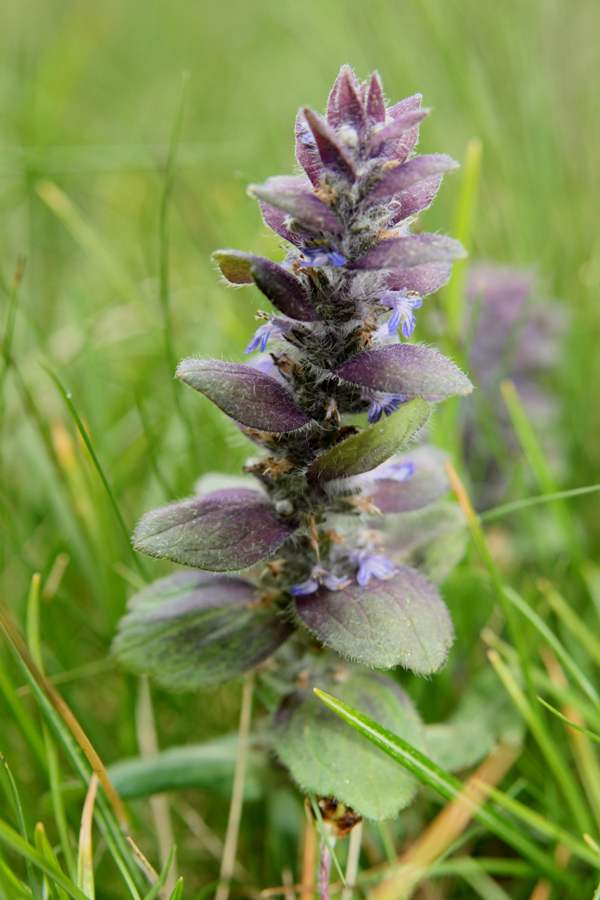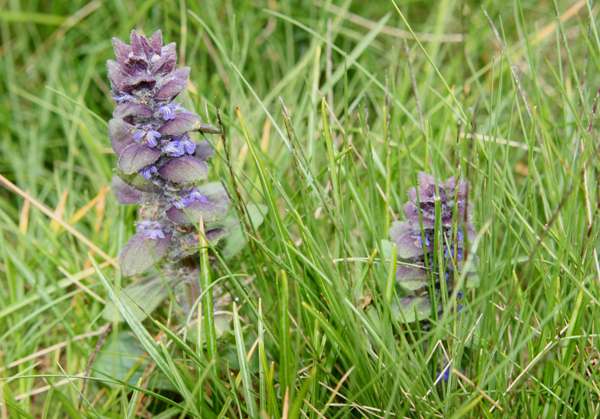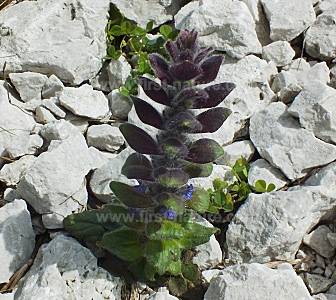Trees Birds Mammals Fish Amphibians Reptiles
Wild Algarve
Bookshop
Ajuga pyramidalis - Pyramidal Bugloss
Phylum: Magnoliophyta - Class: Equisetopsida - Order: Apiales - Family: Lamiaceae

It is always lovely to find something you had more or less given up hope of ever finding, so we found these Pyramidal Bugloss plants growing in the Pirin Mountains National Park in Bulgaria we were delighted.
Description
When this member of the Lamiaceae is in bloom you can see at once that the flowers are generally paler than those of Ajuga reptans with which we are much more familiar. The stems are hairy and bear pairs of opposite hairy leaves that form a squarish pyramid, the lower leaves green and the upper leaves increasingly more purple towards the top of the plant.
Typically 15mm long, the blue flowers emerge from large leafy bracts. Unlike the much more common Bugle, which produces runners from which new plants grow, Pyramidal Bugle has rhizomes rather than runners (stolona). The odds are more heavily stacked again this rarity becoming a common wildflower, because although it is a perennial it does not bloom every year.

Distribution
In Britain these rare plants are seen in just a few locations in northern England and Scotland. They are also recorded from The Burren in County Clare, southern Ireland, and from Rathlin Island in the north, but despite much searching to date we have yet to find them in Ireland. On mainland Europe Ajuga pyramidalis is not such a rare find. We have seen these plants in bloom in Bulgaria, while in Slovenia Pyramidal Bugle is plentiful among limestone rocks in the Julian Alps in areas.
Habitat
Pyramidal Bugle is usually found in short-sward grassland overlaying calcareous rocks; it also occurs within grikes in areas of limestone pavement, most often where it is marshy.
Blooming Times
We also found and photographed these plants in the predominantly limestone Julian Alps in Slovenia on trips there in June 2011 and again in late June 2014, and in Bulgaria in the Pirin Mountains National Park in mid June 2009.

In northern Britain and in western Ireland Pyramidal Bugle usually begins flowering in late April and sometimes continues through May and into early June.
Etymology
Ajuga, the genus name, comes from Greek and means 'without a yoke'. The specific epithet pyramidalis means (no surprise, surely) shaped like a pyramid - that is a square-based cone. (Another wildflower with Pyramidal as part of its its common name is Anacamptis pyramidalis, the Pyramidal Orchid, which before fully expanded actually has a round-based conical inflorescence.)
Sue Parker's latest ebook is a revised and enlarged edition of Wild Orchids in The Burren. Full details here...
Buy it for just £5.95 on Amazon...
Sue Parker's new ebook is a comprehensive and fully revised edition of her acclaimed field guide to the Wild Orchids of Wales. Full details here...
Buy it for just £5.95 on Amazon...
Please Help Us: If you have found this information interesting and useful, please consider helping to keep First Nature online by making a small donation towards the web hosting and internet costs.
Any donations over and above the essential running costs will help support the conservation work of Plantlife, the Rivers Trust and charitable botanic gardens - as do author royalties and publisher proceeds from books by Pat and Sue.